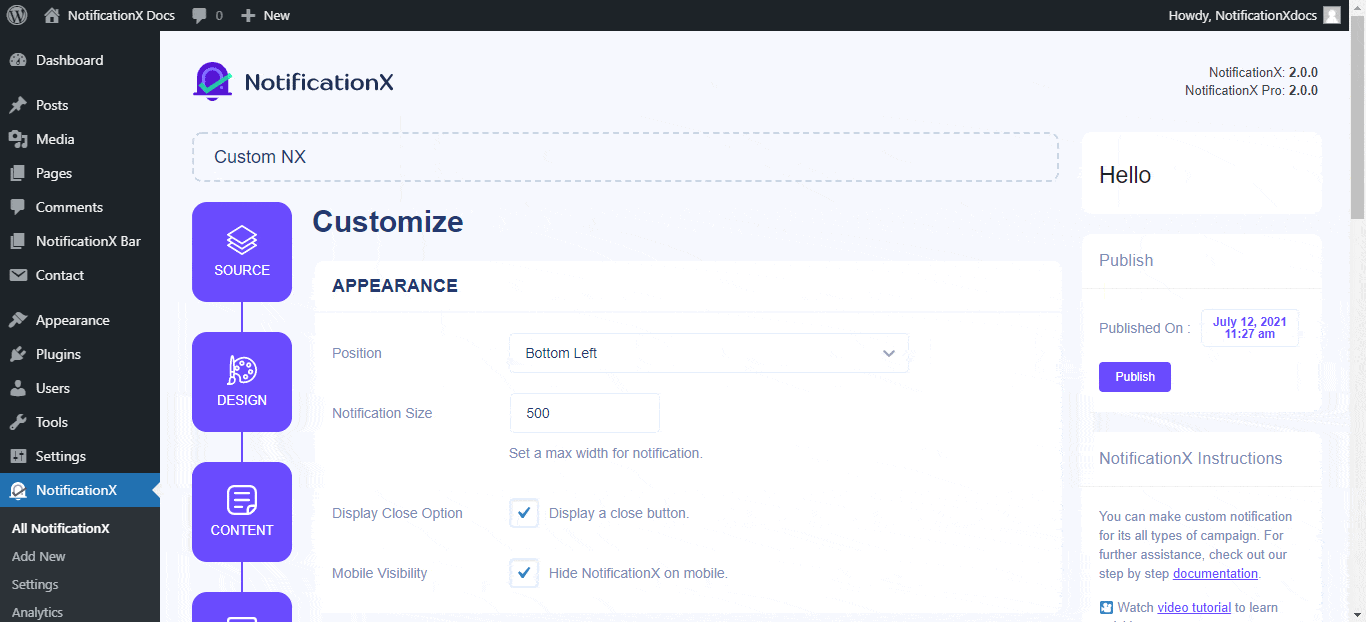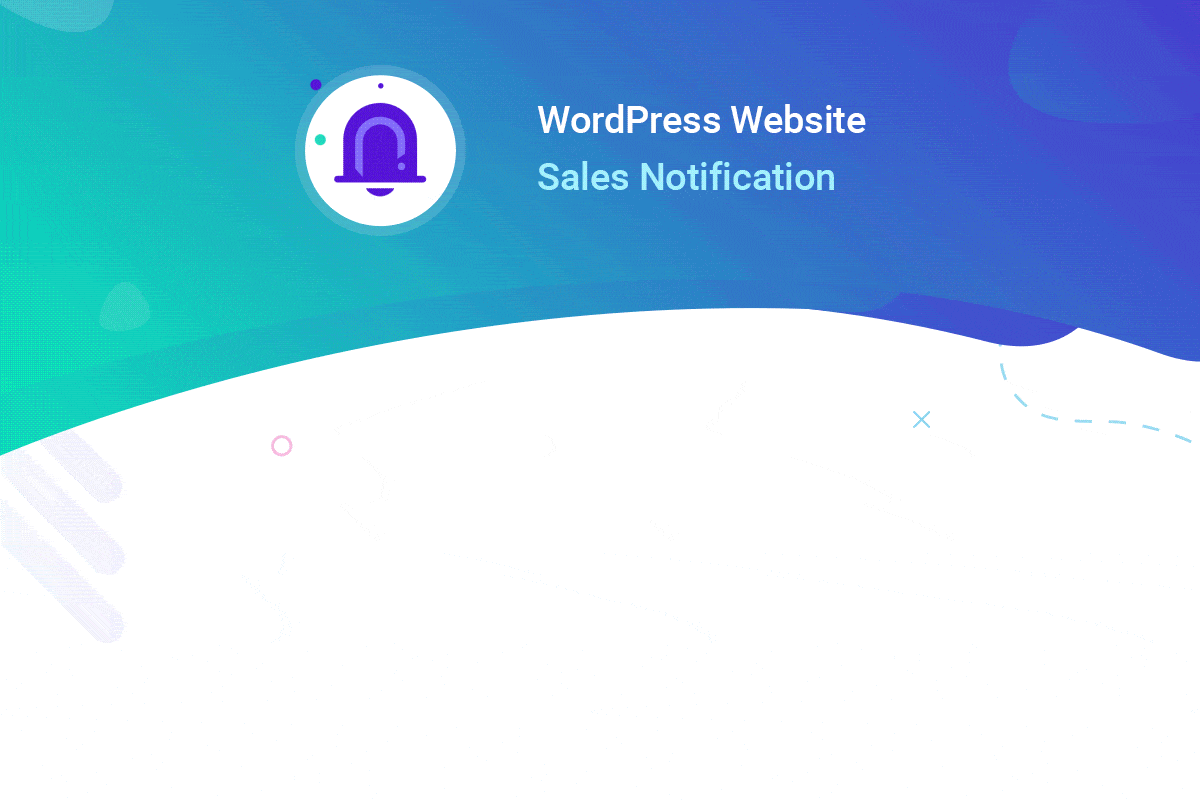NotificationX Pro le permite crear tantas notificaciones de conversión personalizadas como desee y mostrarlas como alertas emergentes sorprendentes en su sitio web. Tendrá la libertad de diseñar y personalizar las alertas FOMO personalizadas de la forma que desee.
¿Cómo crear notificaciones personalizadas con NotificationX? #
Follow the step-by-step guide below to create Notificación personalizada con NotificaitonX:
Paso 1: cree una nueva notificación #
Vaya a su panel de WordPress y navegue hasta NotificaciónX y haga clic en el 'Agregar nuevo ' botón a la derecha en la parte superior. O también puede navegar directamente a wp-admin -> NotificationX -> NotificationX -> Agregar nuevo desde su tablero.

Paso 2: Elija una fuente #
Una vez que haya terminado con el paso 1, será redirigido a 'Fuente' tab page of your NotificationX. Here, you can select ‘Notificación personalizada‘ as your Notification type.

Paso 3: elegir un tema de diseño #
Desde el 'Diseño' pestaña, Desde la 'Diseño' tab, you can choose a ‘tema‘ for your notification alert and this will be the layout of the Custom Notifications that will be displayed on your website. From here, you can pick from a vast amount of themes that allows you to create any type of notification alerts (Sales, Reviews, Comments, Download stats, etc.).

También puede personalizar el tema elegido habilitando 'Diseños avanzados’. From this section, you will be able to easily add styling to your design, image appearance, and typography.
‘Image Appearance‘ section lets you change the ‘Image Shape’ out of these three: Rounded, Circle & Square. You can also use the drop-down menu ‘Position’ to change the position of the image: left or right. Basically, Custom notification consists of Three rows. From the 'Tipografía' sección, también puede cambiar el tamaño de fuente para cada fila.

Step 4: Configure Template Content And Upload CSV #
Here in the ‘Contenido’ tab you can modify your ‘Plantilla de notificación’ and add your preferred content text, add multiple notifications manually one-by-one or create them in bulk using a CSV file. These settings may vary depending on your notification theme selection.

Now upload a CSV file containing notification details to create them in bulk. You can click on the ‘Sample CSV’ button to download a template CSV file and ensure your file format is correct. This template will include all the required columns for your notification data (e.g., title, content, image URL, etc.).

Upload your prepared CSV file containing notification details. Click the ‘Upload CSV’ button and select your CSV file from your computer. NotificationX will validate the uploaded file format. If there are any errors (missing columns, invalid data types), you will receive an error message explaining the issue.

If the CSV file contains more than 100 notifications, a warning message will appear informing you that only the first 100 entries will be processed due to limitations. NotificationX will process the valid entries (up to 100) from your CSV file.

After that, individual notifications will be created based on the information provided in the CSV File. Modify the Notification Template to define the desired text content for your notifications.

Note: Uploading a CSV is an alternative way to create multiple notifications at once. You can still create individual notifications by modifying the Notification Template directly if preferred.

Puedes hacer click en el '+' button to add more custom user information, contents & conversions which will be displayed on your website. Under the ‘Conversion’ section, you will have to fill up all the fields as per your wish. Besides, You can also upload a user/product image of your choosing. You can just go ahead and add as many custom conversions as you want.

Desde 'Opciones de enlace', you can pick a ‘Tipo de enlace’ for your notification popup. Moreover, you can even track the various types of campaigns through NotificationX as well. 'Control UTM' allows you to add ‘Campaign', 'Medio' y 'Fuente’ to your ‘Custom Notification’. Simply click on the ‘Next’ button to continue.
Paso 5: configurar las opciones de visualización #
En el 'Monitor' pestaña, hay dos secciones disponibles: Imagen y Visibilidad. Desde el 'Imagen' section, you can use the checkbox to display the default image or an avatar in the notification popup. If the users don’t have any ‘Avatar’ set in their profile, you can simply display the ‘Default’ image by selecting the ‘Default Image’ checkbox and uploading a default image.
Desde el 'Visibilidad' section, you can set the pages where you want to display the Sales Notification. You also have the option to restrict the notification popup based on certain user roles. On the other hand, you can also specify the pages where you want to display or hide the ‘Custom Notification’.

Paso 6: Configurar la apariencia #
Bajo la 'Personalizar' tab, you will find three separate sections: Appearance, Timing, Behavior & Sound Settings. From the ‘Apariencia’ section, you can set the position where you want to display Custom Notification and use the checkbox to disable/enable the ‘Close Button’ & ‘Hide on Mobile’ options. You can even set a max-width for your Notification Popup as well.

Besides, you also have the freedom to set time for ‘Initial', 'Display For’ & ‘Delay Between’ options as per your preference from the ‘Momento‘ section. You can also set a time limit for how long you want each notification popup to be displayed by modifying the ‘Display For’ field. Or, if you want to display multiple types of notifications, you can simply activate the ‘Gestión de colas global'opción usando NotificationX PRO.

Desde el 'Comportamiento' section, you can choose to display the number of reviews made for certain past days. By checking the ‘Loop Notification’ box, the notification popup will keep on displaying. You can disable this as well.

Con la ayuda de NotificationX PRO, también puede habilitar alertas de sonido para sus notificaciones desde el 'Ajustes de sonido' sección. Puede elegir fácilmente un sonido del menú desplegable que se reproducirá con cada ventana emergente de notificación.

Paso 7: publicación de su notificación #
Después de completar el paso 6, haga clic en el 'Publicar' botón. Como resultado, el ‘Custom Notification’ se creará correctamente.

Siguiendo estos pasos mencionados y un poco más de modificación y estilo, su resultado final se vería así.

Así es como puede diseñar y mostrar fácilmente un 'Custom Notification’ en su sitio web de WordPress utilizando NotificationX. Si tiene algún problema, puede contacta con nuestro equipo de soporte.




